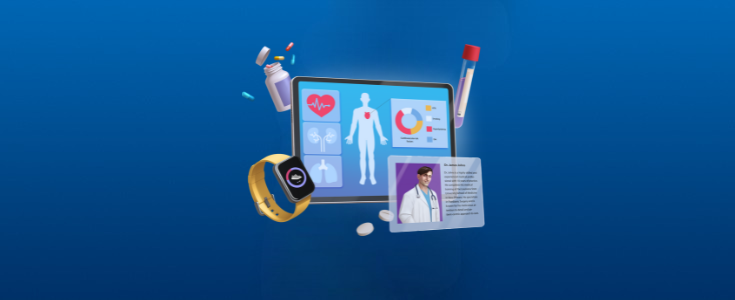Beyond the EHR: Optimizing Clinical Applications for Better Patient Care

Perhaps no other technology represents the digital revolution in healthcare better than electronic health records (EHRs) systems. They have transformed healthcare delivery. They have become the hub for patient data and clinical processes. And they have taken the lion’s share of the spotlight and headlines. But modern healthcare technology involves much more. Nowadays, healthcare organizations rely on an intricate ecosystem of distinct clinical applications to deliver comprehensive, high-quality patient care.
When they work well together, clinical applications enhance the patient experience and optimize clinical workflows. But managing this growing app sprawl — ensuring seamless integration, reducing redundancies, and supporting legacy systems — is an emerging challenge for healthcare IT leaders. The global healthcare integration market is expected to top $12 billion by 2032 1, illustrating the rising demand for integrated systems. Optimizing clinical applications is now a necessity for not only efficiency but also for improving patient care, protecting data, and maintaining financial health. Too often, however, healthcare organizations find they lack the resources to meet this moment on their own. Medix Technology has been partnering with HIT leaders for over 20 years and delivers specialized technology solutions to help you overcome these challenges.
The Indispensable Role of Clinical Applications in Patient Care
While EHRs manage a broad range of patient information, specialized clinical applications offer the finer details and tailored functionality necessary for superior care. These essential tools encompass a wide array of systems, from laboratory information systems (LIS) and radiology information systems (RIS) to sophisticated pharmaceutical tools and specialized applications for fields like OB/GYN or neurology. Clinical applications can be complimentary or they fill the gaps left by EHRs, providing deeper capabilities in areas such as cardiology, gastroenterology, and advanced imaging. This leads to improved diagnostic accuracy, more precise treatment planning, and ultimately, better patient outcomes.
Beyond direct patient care, these applications are vital for operational efficiency and seamless data flow. That effortless data exchange between these specialized apps and the EHR cannot be overstated. When integrated properly, they streamline clinical workflows, reduce administrative burdens, and positively impact the revenue cycle by ensuring accurate billing and timely data capture.
“What we’re seeing is a desire to try to reduce and rationalize all the applications that have been amassed over the last 10 to 20 years to create some sort of streamlined and more effective use of technology,” said Tucker Bogle, Medix Technology Business Development Director.
Key Challenges in Managing a Complex Clinical Applications Ecosystem
Optimizing clinical applications brings challenges rooted in historical practices and rapid industry evolution.
Proliferation and Redundancy
One of the most significant challenges is the sheer number of applications in use, often with overlapping functionalities. This “doctor’s choice” phenomenon, in which individual physician preferences and historical purchasing decisions resulted in ad-hoc tools, has built a fragmented environment of disparate systems. Many of those applications become obsolete over time as physicians retire or gravitate toward new technologies. A health system could have hundreds of physicians, each using their preferred app, creating a monumental administrative burden.
“We have consultants that are specifically focused on looking at these applications, working with the different regions of the health system, determining which ones they like and why, and then going through a full case study of which ones they should consolidate,” said Maggie Casey, Account Executive at Medix Technology. “We’re currently supporting one of the largest nonprofit health systems in their effort to reduce redundancy in their 1900+ application portfolio.”
Mergers and acquisitions (M&A) are another contributor to application sprawl. When two or more health systems merge, they often inherit multiple distinct systems that perform the same function. For example, if Health System A uses three laboratory information systems and Health System B uses four different ones, their merger results in multiple overlapping systems. This longtime lack of centralized oversight has led to complex, redundant application portfolios.
Integration Complexities
Making disparate systems “talk” to one another effectively is a persistent headache. Poorly integrated technologies frequently lead to data silos, duplication, confusion, and increased administrative workload, undermining efficiency2. While standards like HL7 and FHIR are helping to streamline data exchange, full implementation across all software systems often remains elusive for many providers3.
This technology disruption hinders the seamless flow of crucial patient data. Healthcare leaders must get these systems to work in harmony to ensure a cohesive, functional IT environment. The essential role of interface/integration engines is underscored by their 48.7% market share in 2023 within healthcare integration solutions4.
Legacy Application Support and Strategic Transitions
When health systems undergo significant technological shifts, such as implementing new modules within an existing EHR or migrating to a new EHR platform (e.g., Epic), they frequently re-evaluate and replace their existing clinical applications. For instance, transitioning from a standalone laboratory information system like Sunquest to Epic Beaker for lab management necessitates a carefully planned sunset strategy for the legacy application.
During these critical transition periods, organizations face the dual challenge of maintaining operational continuity with existing applications while simultaneously preparing for the new ones. The costs and inefficiencies associated with supporting applications that will soon be decommissioned can be substantial. Organizations often seek external support for these legacy applications, as it’s frequently more cost-effective than dedicating internal resources to a system that will be replaced, especially in light of ongoing operational challenges driven by staffing shortages across the healthcare industry.5
Furthermore, as new clinical applications are integrated or existing EHR modules are optimized, health systems often require support for the ongoing run-and-maintain operations of their established Epic applications. This ensures that daily clinical workflows remain seamless and efficient.
Data Security and Patient Safety Risks
A fragmented application landscape significantly increases data security vulnerabilities. In fact, 2024 witnessed the highest number of significant cyberattacks in healthcare on record, highlighting the urgent need for robust security measures6. These risks include the wrong patient records being accessed during crucial cases and patient information that is unsecure or flowing to unintended destinations. These risks directly impact patient safety and trust.
“Patient information isn’t necessarily secure,” Casey said. “It’s going places it shouldn’t go — and that’s a reality in a lot of health systems right now when they have too many applications.”
Medix Technology’s Approach to Optimizing Clinical Applications
Medix Technology is uniquely positioned to help healthcare organizations overcome these challenges and unleash the potential of their clinical application ecosystem.
Assessment and strategy development: First, we must conduct a comprehensive review of your existing applications, meticulously identifying redundancies, critical integration points, and areas ripe for optimization. From there, we can develop a strategic roadmap for application rationalization and consolidation, tailored to your organization’s unique needs and goals.
Expert consulting and staffing solutions: Our core strength lies in providing specialized analysts, developers, and clinical specialists with deep expertise in niche areas such as PACS, RIS, LIS, and BMDI. Finding such specialized talent can be incredibly difficult for in-house recruiters, a challenge Medix Technology is well-equipped to meet. We address the critical need for both functional and technical roles, ensuring you have the right talent for every aspect of your clinical application strategy.
Seamless integration and implementation: Medix Technology facilitates smooth transitions during mergers and acquisitions and large-scale EHR migrations. We ensure cohesive integration between your clinical, ancillary, and business applications, and provide crucial support for embedding biomedical devices directly into your core clinical systems.
“Organizations have added all these applications, and the systems may not speak to each other,” Bogle said. “It just takes a rearchitecture of applications. How do we integrate all this? How do we rationalize using this application and this application if they can 50% do the same thing? Is there one that’s better, or is there something else out there that we can utilize that covers all of it?”
Legacy system support and modernization: We provide the necessary resources to maintain older systems during critical upgrade cycles or transitions, ensuring continuity of care. Looking ahead, we assist organizations in strategizing for the effective sunsetting of legacy applications, minimizing disruption and maximizing long-term efficiency.
Driving revenue and patient satisfaction: Optimized clinical applications, particularly in imaging (PACS/RIS), are significant revenue drivers. Streamlined imaging processes lead to faster patient access, improved diagnostic turnaround times, and enhanced patient satisfaction. Medix Technology helps connect clinical application efficiency directly to your organization’s financial health.
“It doesn’t just stay clinical,” Casey said. “Clinical applications also have to integrate with the business applications so the revenue can flow down to the bottom line.”
The Medix Technology Difference
What sets Medix Technology apart is our deep industry expertise, agility, and a true partnership approach:
- Decades of expertise: With over two decades of experience in healthcare technology, our team has a deep understanding of the industry’s challenges, best practices, and innovations, ensuring relevant and effective solutions.
- Agility and responsiveness: We work with urgency to identify and deploy the skilled resources and strategic leadership to meet your specific project needs and align with your roadmap, adapting to the dynamic demands of healthcare organizations.
- Proven track record: We have a history of success in helping major health systems rationalize and optimize their clinical application portfolios while maximizing ROI and improving operational performance.
- Partnership approach: We don’t just provide resources; we work as an extension of your team, embedding deep expertise to bridge gaps, scale transformation, and drive better care through technology.
A Healthier Ecosystem for Better Care
With every aspect of healthcare increasingly digital, optimizing clinical applications is no longer optional — it’s essential for delivering high-quality, efficient, and secure patient care. The fragmentation and complexities of these systems can create significant risks and inefficiencies, but they also present a profound opportunity for transformation.
Healthcare IT leaders should look at their current clinical application ecosystems with a critical eye. Identify redundancies, uncover integration gaps, and strategize for a more cohesive future. Medix Technology is your ideal partner to navigate these complexities. By investing in a streamlined clinical application environment, you can unlock new levels of efficiency, bolster security, and — ultimately — achieve superior patient outcomes. Contact us today to get started.
Resources
[1] SNS Insider. “Healthcare IT Integration Market Size to Hit USD 12.97 Billion by 2032, Growing at a 12.69% CAGR – SNS Insider.” GlobeNewswire. Accessed June 24, 2025. https://www.globenewswire.com/news-release/2025/01/16/3010864/0/en/Healthcare-IT-Integration-Market-Size-to-Hit-USD-12-97-Billion-by-2032-Growing-at-a-12-69-CAGR-SNS-Insider.html
[2] Simbo AI. “Understanding the Common Challenges in Clinical Workflow Management and Exploring Effective Solutions.” Simbo AI Blogs. Accessed June 24, 2025. https://www.simbo.ai/blog/understanding-the-common-challenges-in-clinical-workflow-management-and-exploring-effective-solutions-2913923/.
[3] Signify Research. “Top Five IT Challenges Facing Healthcare Technology Leaders.” Signify Research. Accessed June 24, 2025. https://www.signifyresearch.net/insights/top-five-it-challenges-facing-healthcare-technology-leaders/.
[4] Market.us. “Healthcare Integration Market Size, Share Analysis | CAGR of 9.7%.” Market.us. Accessed June 24, 2025. https://media.market.us/healthcare-integration-market-news/.
[5] THL. “2023 Healthcare Trends and Our Outlook for 2024.” THL. Accessed June 24, 2025. https://thl.com/articles/thl-insights-2023-healthcare-trends-and-our-outlook-for-2024/.
[6] PwC. “Next in health services 2025: Secure your future with resilience and reinvention.” PwC. Accessed June 24, 2025. https://www.pwc.com/us/en/industries/health-industries/library/healthcare-trends.html.




